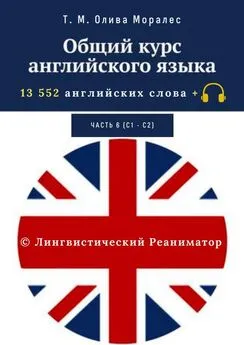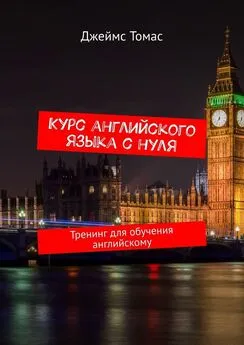Яков Аракин - Практический курс английского языка 2 курс
- Название:Практический курс английского языка 2 курс
- Автор:
- Жанр:
- Издательство:ВЛАДОС
- Год:2005
- ISBN:нет данных
- Рейтинг:
- Избранное:Добавить в избранное
-
Отзывы:
-
Ваша оценка:
Яков Аракин - Практический курс английского языка 2 курс краткое содержание
I - V курсов педагогических вузов.
Цель учебника – обучение устной речи на основе развития необходимых автоматизированных речевых навыков, развитие техники чтения, а также навыков письменной речи.
Практический курс английского языка 2 курс - читать онлайн бесплатно полную версию (весь текст целиком)
Интервал:
Закладка:
has changed the face of Red Square it' has remained the main square and the heart of the city.
Visitors from home and abroad stream here to enjoy the beauty of the historic buildings and
monuments of which the Kremlin comes first. The Kremlin represents centuries of Russian history
and one is usually struck by the austere and powerful appearance of its walls and towers.
Like the Tower of London the Kremlin was used as a fortress and a sovereign's residence.
Now it houses the President's office and a number of museums including the Armory Chamber and
the Diamond Fund.
In the centre of the square by the Kremlin wall is the Lenin Mausoleum, erected in 1930 by
A. Shchusev. The architect interpreted the traditions of the pyramids in a modem way and gave the
monument a laconic architectural form which was popular in the twenties. Behind the Mausoleum
there is a necropolis of some outstanding statesmen and political leaders.
On the southern side of Red Square is St. Basil's Cathedral (Vasily Blazheny), a masterpiece
of ancient Russian architecture. It was built in 1555 — 61 in memory of the victory over Kazan
(1552). The monument standing in front of the Cathedral tells us of the people's victory over the
Polish invaders in 1612. The inscription on the monument reads: "To Citizen Minin and Prince
Pozharsky from a grateful Russia". The monument is the work of I. Martos (1752—1835). Not far
from the Cathedral is what is called the Lobnoye Mesto, a platform of white stone more than 400
years old. The tsar's edicts were proclaimed there. Public executions were carried out on a wooden
scaffold erected nearby. To the right of the Cathedral on the territory of the Kremlin we can see a tall
tower, more like a column, over 80 metres high. It is the Bell Tower of Ivan the Great built in the
15th century. There are twenty-two large bells and over thirty small ones in it. For centuries the
eastern side of Red Square had been associated with trading. The first stone shops were built here in
the 16th century. Today on their site stands the State Department Store, better known as GUM.
If we walk up from St. Basil's to the opposite end of the square we face a red brick building.
This is the History Museum. In the west Red Square is adjoining the Kremlin. Just on the other side
of the Kremlin wall we can see the building of the former Senate, an outstanding architectural
monument built by Matvei Kasakov (1738—1813), now the seat of the Administration of the
President. A number of watch-towers protect the Kremlin bridges. The white Kutafya Tower is the
best survivor of all of them. The tallest one is the Trinity Tower (80 m high). But the Spasskaya
Tower with the Kremlin clock has long since become one of the symbols of Moscow.
Memory Work
Sonnet Composed upon Westminster Bridge
Earth has not anything to show more fair:
Dull would he be of soul who could pass by
A sight so touching in its majesty:
This City now doth like a garment wear
The beauty of the morning; silent, bare,
Ships, towers, domes, theatres, and temples lie
Open unto the fields, and to the sky:
All bright and glittering in the smokeless air.
Never did sun more beautifully steep
In his first splendor, valley, rock or hill;
Ne'er saw I, never felt, a calm so deep!
The river glideth at bis own sweet will:
Dear God! the very houses seem asleep;
And all that mighty heart is lying still!
William Wordsworth
ESSENTIAL VOCABULARY (II)
Words
adjoin υ
defeat υ
jewel n
architecture n
dome n
mansion n
armour n
erect υ
residence n
avenue n
float υ
seat n
bury υ
fortress n
shady adj
change υ
guard υ
specimen n
cathedral n
huge adj
statesman n
contain υ
Word Combinations
to live from hand to mouth
to win the victory
to be lined with (trees, houses)
at the cost of smb.'s life
to be found (in some place)
at the top
a new housing development
round the corner
to have (get, catch) a glimpse of
to be famous for smth.
to have no time (money, etc.) left
in present days
across the road (from some place)
Why not do smth.?
to do the sights of smth.
in memory of
to do the city (museums, parks, etc.)
under the command
Proper Names
the Lenin Mausoleum
Big Ben
the East End
Trafalgar Square
the Tower of London
the Kremlin
Julius Caesar
the West
End
William the Conqueror
St. Basil's Cathedral
Queen Elizabeth
the
Bell Tower
Christopher Wren
of Ivan the Great
Wellington
the History Museum
Westminster Abbey
the Spasskaya Tower
EXERCISES
I. Study Text A and explain the meaning of the words and phrases listed below:
mansion, to live from hand to mouth, miserable houses, to line the streets, dome, slums, to
come first, the Crown Jewels, huge, statesman, across the road, the seat (of the government), at the
cost of somebody's life, to face smth., shady avenues.
II. Learn the words of the texts and a) copy and transcribe these words:
mansion, restaurant, jewel, guard, halt, column, ton, sovereign, national, float, sculpture,
swan, weigh, conqueror, specimen.
b) Translate into English and mark the stresses:
отель, церемония, Возрождение, Трафальгарская площадь, рукопись, проспект,
архитектор, Елизавета, сенат.
c) Form derivatives of these verbs by adding the prefix re- (meaning "do smth.
again"):
Example: build — rebuild
write, tell, construct, arm, elect, produce.
III. Answer the questions:
1. How do the two parts of London differ from each other? 2. Why is it better to start
sightseeing from the Tower of London? 3. Who founded the Tower and when was it rebuilt? 4. What
was the Tower of London used for? 5. What is the City? 6. What does the phrase "a place of interest"
mean? 7. What do you know about St. Paul's Cathedral? 8. What is Whitehall and in which part of
London is it situated? 9. What does the Ceremony of the Keys consist of? 10. What do you call the
building in which the Houses of Parliament are situated? It is one building, why then do we say "The
Houses of Parliament"? 11. What is Big Ben? 12. What kind of museum is the British Museum? 13.
What do you know about Hyde Park?
IV. Read the text and show all the places of interest mentioned there on the
map:
Trafalgar Square is the natural centre of London. Could we but stand 168 feet (about 50
metres) above the traffic, beside the figure of the Admiral, we really could see all the great
landmarks of London. Whitehall, which leads out of the square to the south, is the site of many
Government offices including the Prime Minister's residence, Foreign Office, War Office; at the far
end of Whitehall stand, beside the Thames, the Houses of Parliament with the Big Clock Tower, and
Westminster Abbey; to the left Covent Garden fruit market and Covent Garden Opera House, and
beyond the Bank of England; another slight turn left would enable your eye to fall on the British
Museum; further left still we should see theatreland around Piccadilly Circus (it is not at all a circus
but an open space of a circular form) and those expensive shopping promenades — Regent Street,
Oxford Street, Bond Street; a little further, and into view would come Hyde Park in the distance,
with, nearer, Buckingham Palace, and Royal Drive known as the Mall, which leads into Trafalgar
Square.
V. Use Text В to practise similar conversations on Moscow.
VI. Read and retell:
A. The famous square mile of the City of London is administered as an independent unit,
having its own Lord Mayor and Corporation and its own police force. It was here that the Romans
built their walled town of Londinium, a few traces of which remain today, and it was here that the
Medieval guilds established their headquarters. When after the Great Fire of 1666, the City was
rebuilt, stone and brick replaced the many mainly wooden medieval houses and from that time the
City gradually became a financial and commercial centre.
B. One of the special joys of London is the amount of space given over to parks, gardens,
squares and open areas. They provide a welcome visual and physical break from the mass of
buildings and the heavy traffic. Kew Gardens are famous Botanic Gardens on the banks of the
Thames. The gardens and hothouses with rare flowers, trees and shrubs are well worth seeing.
Within a stone's throw of Buckingham Palace are St. James's Park and Green Park. St. James's Park,
the oldest in London, was created by Henry VIII and redesigned by his successors. Green Park, as its
name suggests, mainly consists of lawns and trees.
(From Colourful London. Norwich, 1981)
VII. Make up short situations or dialogues, using tne following words and
phrases:
1. why not..., let me see, to be found, across the road, to have no (time, money) left; 2. in
present days, to live from hand to mouth; 3. under the command of, to be famous for, to defeat, to
win the victory, at the cost of; 4. fortress, armour, in memory of, to contain; 5. swan, lined with trees,
float, shady avenues, ancient.
VIII. Fill in prepositions:
Scotland Yard is the headquarters ... the Metropolitan Police ... London. ...most people, its
name immediately brings ... mind the picture ... a detective — cool, collected, efficient, ready to
track down any criminal.
Scotland Yard is situated ... the Thames Embankment close ... the Houses ... Parliament and
the familiar clock tower ... Big Ben. The name "Scotland Yard" originates ... the plot ... land
adjoining Whitehall Palace where, ... about the 14th century, the royalty and nobility ... Scotland
stayed when visiting the English Court. The popular nickname ... the London policeman "bobby" is a
tribute ... Sir Robert Peel, who introduced the police force ... 1829, and whose Christian name
attached itself ... members ... the force.
IX. Review Text "Introducing London", texts A, B, Exercises IV, VI, VIII and
study the map of London. Speak on the given topics:
1. London dominates British life. 2. The West End. 3. The East End. 4. The City. 5. The
Tower. 6. The district of Westminster. 7. The British Parliament. 8. Whitehall and Fleet Street. 9.
Trafalgar Square. 10. St. Paul's Cathedral. 11. The parks of London. 12. London museums. 13.
London traffic. 14. Monuments in London.
X. Translate into English:
1. В самом центре Сити, напротив главного банка Англии, стоит статуя Веллингтона —
Читать дальшеИнтервал:
Закладка:
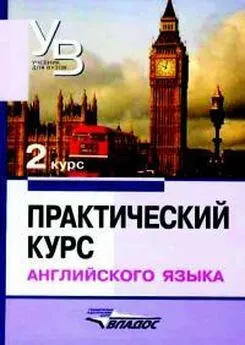
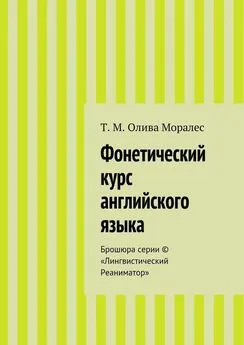


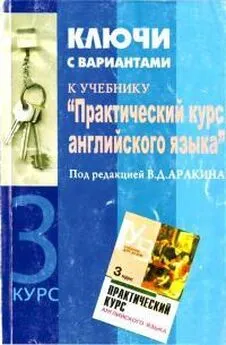
![Владимир Аракин - Практический курс английского языка 3 курс [calibre 2.43.0]](/books/1072035/vladimir-arakin-prakticheskij-kurs-anglijskogo-yazyk.webp)



